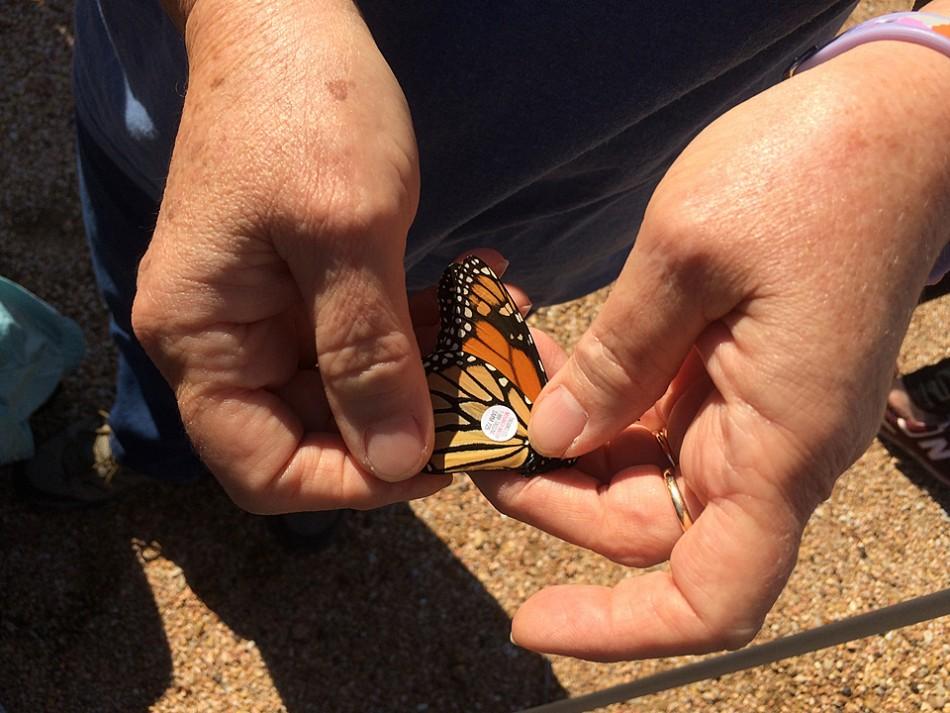Hands-on teaching incites passion in students
Patricia Ehsani hustles over to the plot of purple flowers with four butterfly nets in her hands. She hands two students a net, and they quickly catch two butterflies. The students excitedly wait for her instructions.
She digs in a blue bag, and when she finds what she’s looking for, she turns to the first net and carefully pulls out the insect. In a string of concentrated movements, Ehsani turns to a student and shows him how to tag the butterfly’s wing.
With the butterfly tagged and the job complete, Ehsani turns to the group of students.
“Who wants to let her go?” Ehsani’s AP Environmental Science class isn’t all butterflies and teamwork. It’s also pill bugs and hatching chicks and dirt samples and sometimes it’s taking pictures of scat.
More importantly, her class isn’t bound by four walls and a desk. On Oct. 28, Ehsani took her second and third period “APES” classes on a field trip to the John Bunker Sands Wetland Center. The field trip gave students the opportunity to apply what they learned in class to real life scenarios.
“A textbook can only go so far,” Ehsani said.
This motto applies to all of Ehsani’s classes as her students have the opportunity to work firsthand with the concepts they are learning.
“It’s cool incorporating all the knowledge that we’ve learned in class and actually getting to do the field research,” Senior Rachel Marquez said. “All the activities that she’s trying to incorporate into the class makes it more active and hands-on, so more people are getting passionate about science.”
Ehsani’s own love of the natural world began as a child.
“I had lived in West Virginia,” Ehsani said, “and I used to purposely go back into the woods behind the town and get myself lost just so I could find my way back. So even at a young age I was fascinated with nature.”
Her love of science came next, and the study of environmental science grew as she did.
“Environmental science hadn’t been invented yet when I was in high school,” Ehsani said. “I remember in high school we got out of school [to] plant a tree for the second Earth Day. [Environmental science] was something brand new.”
Currently, Ehsani supplements her college education with volunteer work. She is a member of the Texas Master Naturalists, an organization devoted to educating the community on environmentalist issues and the management of the state’s natural resources. The organization requires volunteers to complete forty service hours a year.
“I needed to learn more so that I could teach APES,” Ehsani said, “and someone sent me an email saying ‘Hey, the Master Naturalists are opening up a class’ … So I joined and fell in love with it. It’s a good group of people who are volunteering their time and effort to take care of the environment and to educate others about the environment.”
She also works with the Texas Stream Team. Volunteers “adopt” a site to test water quality and report their findings for academic research. While most volunteers adopt one site, Ehsani has adopted two.
“I went through the training and thought, ‘Well, okay, I think it would be interesting to test the water quality above the dumps at Lewisville and below the dumps and see if there’s a difference,’” Ehsani said. “So I adopted two.”
Ehsani tests the sites once a month with her husband, recording a variety of parameters like windiness, cloud cover, and pH.
When Ehsani comes back to her classroom, she brings her volunteer experience, and her students benefit from her firsthand knowledge.
“She’ll always tell examples about her and her husband going out and doing different conservation projects like trying to catch butterflies, going to different places, and hiking the Appalachian Trail,” Marquez said. “She’ll just make [things] more personal and meaningful.”
Ehsani’s students appreciate her classroom’s interactive nature, a characteristic of her teaching that comes from a deep understanding of the topic she teaches.
“I love the fact that she knows what she’s doing,” senior Kavya Ramagiri said. “I feel like a lot of time teachers are just kinda there.”
Ehsani’s effort to create a connection between her students and the material she teaches stems from her own environmentalism and her confidence that younger generations can fix global environmental and socioeconomic issues.
“I want students to be able to critically look at an environmental issue and understand the legal, the cultural, the social, the personal, the natural world,” Ehsani said, “all of those influences coming together because I want students to be able to make informed decisions when they try to decide if there’s a problem that needs to be fixed… And you guys have a lot of problems to fix.”
In her eyes, the first step towards solving the problems starts with education.
“I’m trying to help students understand the importance of protecting the environment,” Ehsani said. “To protect the environment, you’ve gotta be able to experience and measure the environment. And then you create a passion.”



